Volume 5 Winter 2011 Number 2 - Charleston Law Review
Volume 5 Winter 2011 Number 2 - Charleston Law Review
Volume 5 Winter 2011 Number 2 - Charleston Law Review
You also want an ePaper? Increase the reach of your titles
YUMPU automatically turns print PDFs into web optimized ePapers that Google loves.
CHARLESTON LAW REVIEW [<strong>Volume</strong> 5The Dunn and Dunn model, 48 with which many legaleducators have at least a glancing familiarity, investigatesstudents’ self-reported preferences for learning according toenvironmental, emotional, sociological, and physiologicalvariables. 49 Environmental variables include factors such assound, temperature, light, and seating design. 50 Emotionalvariables include motivation, persistence, and the need forstructure. 51 Sociological variables include preferences for workingalone or with peers or with authoritative or collegial adults. 52Although physiological variables include preferences for time ofday, mobility, and eating and drinking, it is perhaps the modalitypreferences that are most familiar—that is, whether individualsreport a preference for visual, auditory, kinesthetic, or tactilelearning. 53The latter idea is often referred to as VAKT or VAK, and itsessential premise is that learners differ with respect to basicsensory preferences and environmental stimuli. VAKT theorysuggests that there is a biological foundation to the self-identifiedpreferences that learners specify on various learning style48. The model was developed by the husband and wife team of KennethDunn and Rita Dunn. Dr. Kenneth Dunn received his doctorate inAdministration of Schools Systems from Columbia University and is a long-timeprofessor at City University of New York. See Curriculum Vitae of Kenneth J.Dunn, QUEENS C. OF THE CITY U. OF N.Y. INDEX OF FAC. CURRICULUM VITAE(2008), http://qcpages.qc.edu/ECP/FVitae/dunnvitae08.pdf. Dr. Rita Dunntaught at St. John’s University for over 40 years before her death in August2009. See Rita Dunn’s Obituary, N.Y. TIMES, Aug. 7–8, 2009 available athttp://www.legacy.com/obituaries/nytimes/obituary.aspx?page=lifestory&pid=131050944. Information about the Dunn and Dunn Learning Styles theory andcorrelated assessment instruments may be found at http://www.learningstyles.net/ (last visited Oct. 22, 2010).49. See Coffield, Learning Styles and Pedagogy in Post-16 Learning, supranote 10, at 22, Table 3; see also Boyle, Minneti & Honigsfeld, supra note 12, at157 (citing RITA DUNN & KENNETH DUNN, THE COMPLETE GUIDE TO THELEARNING STYLES INSERVICE SYSTEM 34 (1999)).50. See Coffield, Learning Styles and Pedagogy in Post-16 Learning, supranote 10, at 22, Table 3.51. Id.52. Id.53. Id. For a study of law students’ learning styles based on the Dunn andDunn model, see Boyle, Minneti & Honigsfeld, supra note 12.146







